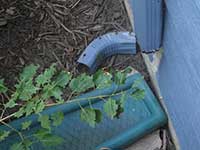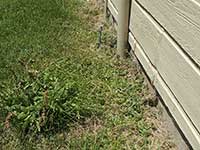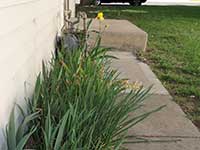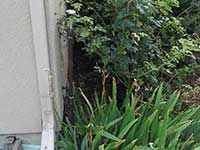Foundation Grading Around Your House
Good vs Bad Grading
In 2,000 inspections, over the last 8 years, I find one common defect that must be corrected on at least portions of 99% of those homes, which is negative grading.
Aside from immediate safety hazards, this condition is the most important to correct than any other, for several reasons.
99% of foundation issues are related to water. Allowing water to pond near the foundation will saturate the soils and can create pressure that pushes the foundation walls inward. Among other issues are moisture intrusion into the basement/crawlspace and moisture eroding the bearing under concrete slabs allowing them to drop.
Positive Grading
When the contractor excavated for your foundation, they over-dug by several feet to allow working room to build the foundation. Once completed, they back-filled the void, creating a positive grade (slope) away from the foundation. This disturbed back-fill continues to settle and compact for 100’s of years. Adding moisture to this loose soil accelerates the compaction process.
As a Builder of custom homes, I recall notes on every engineered foundation drawing that clearly stated “do not plant anything within 3 feet of the foundation and always maintain a positive slope away from the foundation”. The majority of homes that I inspect have trees, bushes, shrubs and/or grass planted right next to the foundation, all of which need WATER, which causes the affected grading to sink a little each year. Add to this, those pesky gutter downspout extensions that invariably remain in the “UP” position or are missing altogether. Never instal
l irrigation next to the foundation as subsurface fittings likely will eventually leak.
What to Do about Negative Grading
So if you discover areas of negative grading around your home, where the ground is sloping towards your house, pull back any landscaping materials and any fabric, add dirt or structural fill material to create a positive slope away from the foundation for several feet, being careful to keep soil away from the bottom edge of siding materials, then re-install the fabric and landscape materials. Simply adding mulch or rock will not correct the condition, as water will pond under these materials. Be sure to check under decks, as water can pond there also. In general, the newer the home, the more often you will have to inspect and correct areas of sinking soils around your home.
If a flat site will not allow for positive grading, then dig down and create a swale, or French drain, that will divert water away from the foundation.
Most people understand the need to prevent moisture intrusion, whether it be your roof, windows or for example, you car. By keeping the soils near your home dry, even in a rainstorm, you can prevent a host of problems. Remember, THINK LIKE A DRIP.



